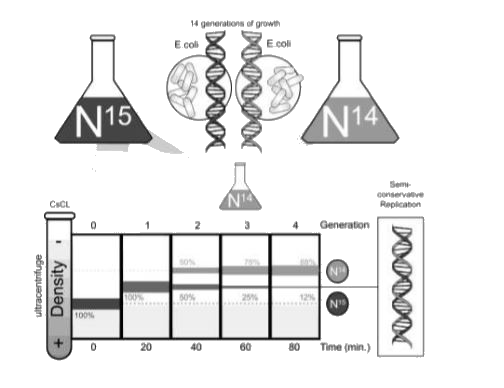The diagram below represents Meselson and Stahl's experiment on DNA replication.

For several generations, E. coli was grown in a medium containing an isotope of nitrogen, N15 . DNA was extracted periodically, at successive generations, and it was subjected to ultracentrifugation to check the percentage of the isotope that was transmitted across generations.
How did the centrifugation process help in providing evidence of the nature of DNA replication?
It mixed the medium well.
It destroyed the heavy isotope.
It allowed the DNA with N14 to settle down.
It separated the DNA with nitrogen isotopes based on densities.
The correct Answer is:D
Step by step video & image solution for The diagram below represents Meselson and Stahl's experiment on DNA replication. For several generations, E. coli was grown in a medium containing an isotope of nitrogen, N^(15) . DNA was extracted periodically, at successive generations, and it was subjected to ultracentrifugation to check the percentage of the isotope that was transmitted across generations. How did the centrifugation process help in providing evidence of the nature of DNA replication? by Biology experts to help you in doubts & scoring excellent marks in Class 12 exams.
Updated on:21/07/2023Topper's Solved these Questions
Similar Questions
Knowledge Check
The isotope used by Meselson and Stahl in their experiment was
AO18BC14CH3DN15Mode of DNA replication in E. coli is :-
AConservative and unidirectionalBSemi conservative and unidirectionalCconservative and bidirectionalDSemi conservative and bidirectionalMeselson Stahl experiment on semiconservative replication demonstrate that :
A50% radioactive, 50% non- radioactiveB50% non-radioactiveC50% radioactiveDnone of the above
Show DNA replication with the help of a diagram only.
View SolutionMode of DNA replication in E. coli is :
View SolutionDuring Meselson and Stahl's experiments, heavy DNA was distinguished from normal DNA by cetnrifugation in :
View SolutionDuring Meselson and Stahl' experiments, heavy DNA was distinguished from normal DNA by centrifugation in
View SolutionIsotopes used in proving semi-conservation replication of DNA were
View Solution
